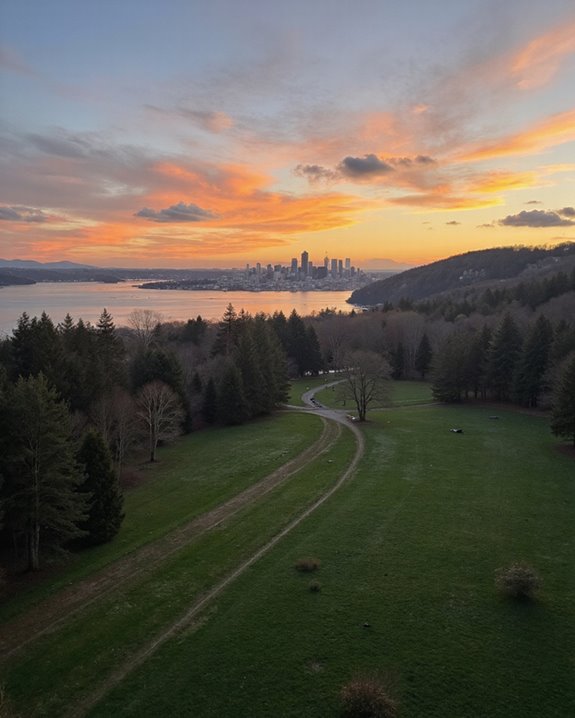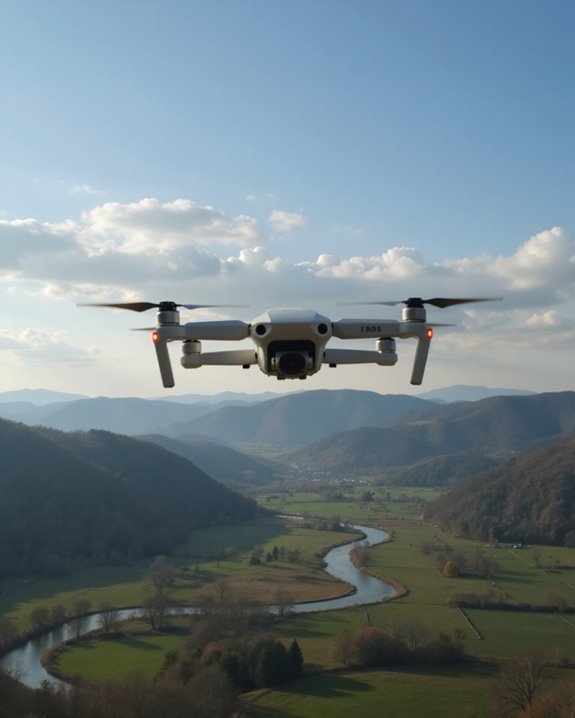Marymoor Park Airfield is hands down the best spot near Seattle for flying your drone—think wide, open fields run by the Marymoor RC Club, plus killer views of Lake Sammamish and evergreens. It’s the go-to place, since most city parks are frustrating no-fly zones, and here, you’ll find fellow enthusiasts, competitions, and even monthly meetups. Just don’t land in a tree! If you’re curious about where else you can launch, there’s plenty more info to discover.
Key Takeaways
- Marymoor Park’s northeast RC field is a top legal spot for drone practice, offering open fields and club support.
- Most Seattle city parks are no-fly zones; always check the FAA UAS Data Map or B4UFLY app before flying.
- Local RC clubs and community forums can help you discover additional legal drone practice locations around Seattle.
- Always avoid restricted airspace near airports and obtain necessary permits for state parks or special events.
- Practice in Class G airspace areas like Marymoor Park, which do not require Air Traffic Control clearance for recreational drones.
Marymoor Park Airfield: Seattle’s Premier Drone Flying Site
Nestled in the northeast corner of Marymoor Park and overlooking the sparkling waters of Lake Sammamish, Marymoor Park Airfield stands out as Seattle’s go-to spot for drone enthusiasts who want more than just a patch of grass. This airfield, run by the Marymoor RC Club, is where Park Integration truly shines—imagine flying your drone while surrounded by towering evergreens and eagle-filled skies! There’s a real sense of community, especially during Seasonal Flying events like summer flight training and buzzing competitions. Monthly meetings keep pilots connected, and the wide, open field means plenty of space for practicing aerial maneuvers without dodging soccer balls. If you’re ready for a scenic view (and maybe a modest audience of ducks), Marymoor offers a unique, welcoming drone experience.
Understanding Seattle’s Drone Regulations and Restrictions
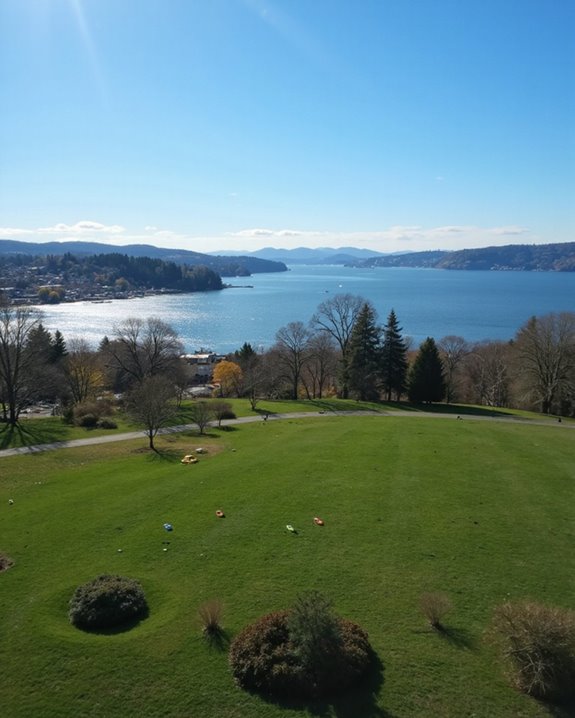
Regulations are a big part of flying drones in Seattle, but don’t let the red tape ground your excitement! Before you rush out with your drone, remember that Seattle’s parks are a no-fly zone, and there’s a strict Capitol Ban—no drones allowed on the Capitol Campus due to safety and disruption concerns. Want to fly at a special event? You’ll need a City of Seattle Master Film Permit. However, there are Emergency Exceptions: authorized personnel can fly drones for emergencies. The Department of Enterprise Services works with the Washington State Patrol and FAA to enforce these rules. Don’t forget, the FAA requires hobbyists to pass the TRUST test and register drones. Respect these guidelines, and you’ll keep your flights fun—and legal! Additionally, choosing drones that weigh under 249g can help you avoid FAA registration for recreational use, making compliance easier with FAA regulations.
Navigating Airspace Classes Around the Seattle Area
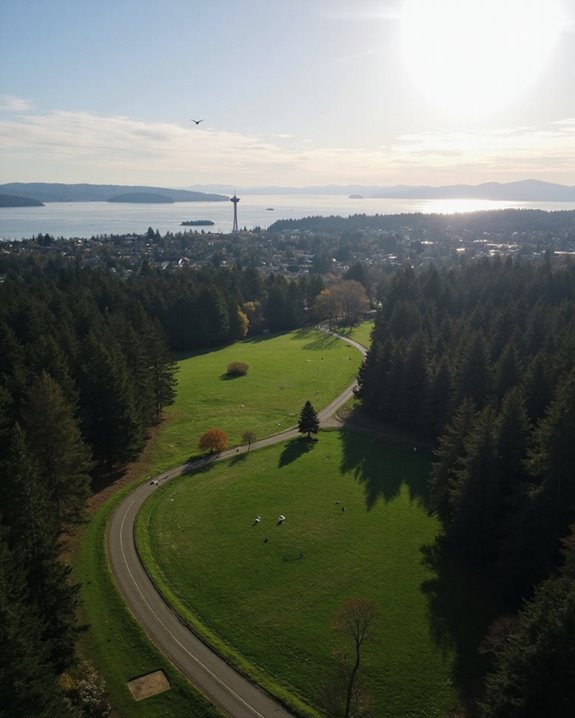
Ever wonder where you can actually fly a drone around Seattle without getting into trouble? Handling airspace classes is like solving a puzzle—one with some pretty important Airspace Boundaries you can’t ignore! Around Seattle, Class B airspace hugs major airports like SEA, so unless you’ve got special FAA approval, it’s a no-go zone. Smaller airports, like those near Luther Burbank Park, fall under Class D airspace, which means you’ll need to chat with Air Traffic Control before taking off. For stress-free flights, Marymoor Park is a favorite—its Class G airspace is uncontrolled and drone-friendly! Using Navigation Techniques, like checking the FAA’s B4UFly app or UAS Facility Maps, helps keep you clear of trouble. Always remember: airspace is serious business, but exploring legally is totally doable! Additionally, equipping your drone with a Remote ID module is essential to ensure compliance with FAA regulations when flying in controlled airspace.
Tips for Finding Legal Drone Zones Near Seattle
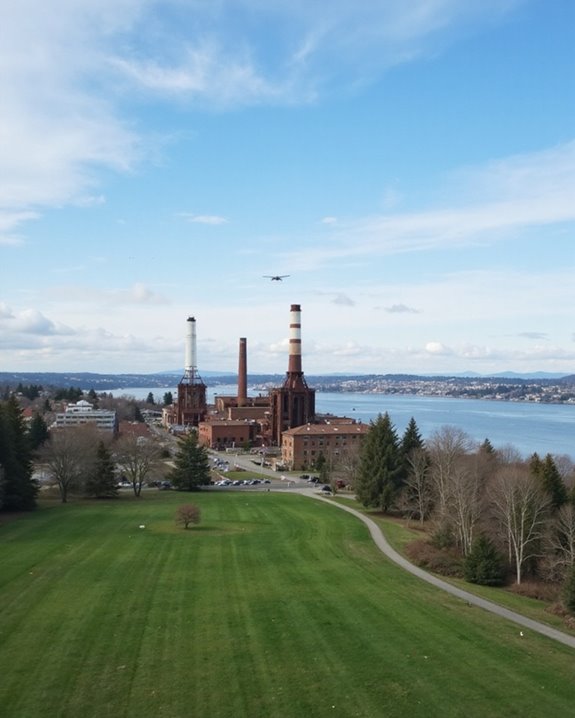
How does someone actually find a legal spot to fly a drone near Seattle without playing a guessing game with the rulebook? Zone Discovery starts with knowing your airspace—Class G airspace is the sweet spot for most recreational pilots! Legal Scouting means checking the FAA UAS Data Map or the Aloft (B4Ufly) app before taking off. Always steer clear of airports like SEA and national sanctuaries; those are absolute no-fly zones. Local parks like Marymoor Park Airfield are great, but don’t forget your membership card. Asking in community forums can reveal hidden gems, and GPS navigation helps you stay within boundaries. Remember, flying over private property requires permission, and waterways can be tricky due to marine rules. Being smart about Zone Discovery means flying safely and stress-free! Using a FAA Compliant Remote ID Module can also help ensure your drone flights meet regulatory requirements and enhance safety.
Applying for Permits to Fly in Washington State Parks
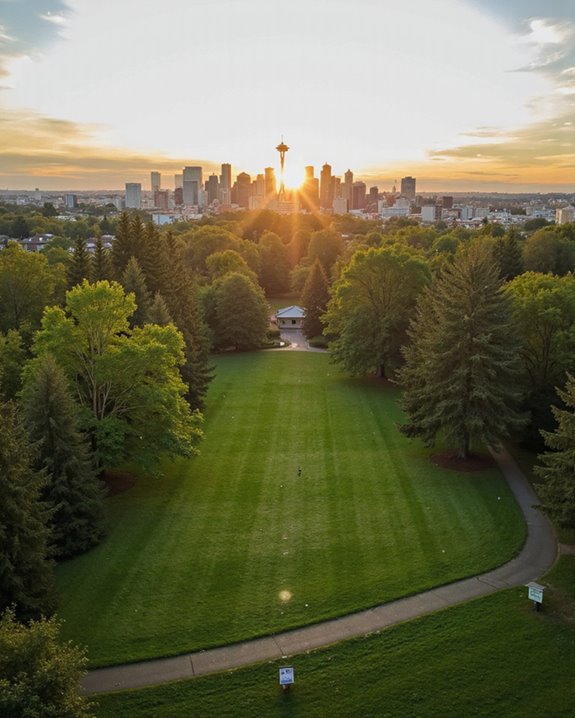
Once a perfect flying spot is found, there’s one more hurdle before taking off over those beautiful Washington State Parks: getting official permission! Every drone flight in these parks requires a written permit from the park Director or their designee—yes, even for that quick sunrise shot. The application, called the “Remote Controlled Aircraft Permit,” must be filled out and submitted at least 60 days before your planned flight, so don’t wait until the last minute—Permit Deadlines are real! The Review Process is thorough, asking for details like your flight plan, purpose, and dates. Both recreational and commercial pilots need to apply, but commercial requests face more scrutiny. Carry your approved permit at all times—park rangers love paperwork almost as much as beautiful drone footage!
Commercial Drone Operation Requirements in Seattle

Commercial drone operations in Seattle call for more than just a knack for flying—pilots need to follow a checklist of rules, paperwork, and training to stay on the right side of the law! First, every commercial pilot must earn a Remote Pilot Certificate under FAA Part 107, and don’t forget, Certificate Renewal is a must to keep flying legally. Drones must be registered with both the FAA and Washington’s Aviation Division, and those documents need to be handy in case someone asks! If you want to fly over city property or at events, expect to fill out extra permits. Smart operators also invest in Insurance Policies—accidents happen, and Seattle weather is unpredictable! Training, continuing education, and safety protocols keep everyone sharp, safe, and ready for Seattle’s drone scene.
Exploring Club Memberships for Safe Drone Practice
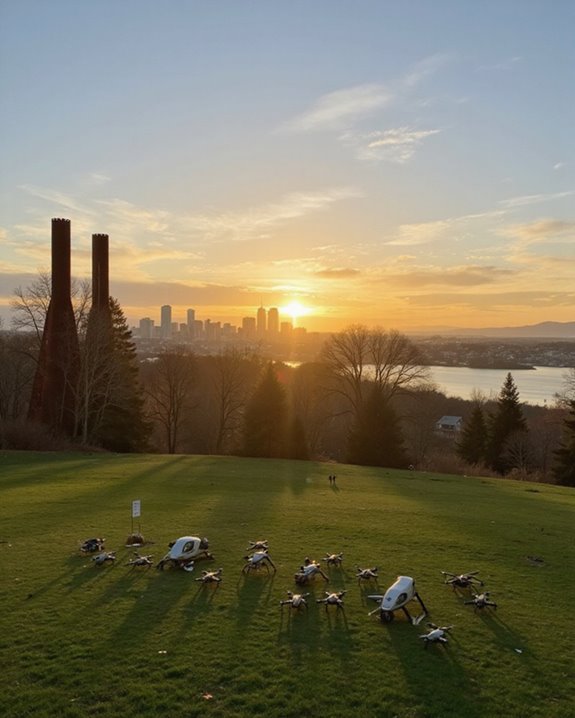
Curious about where Seattle’s drone enthusiasts sharpen their skills and make new friends? Local clubs, like the Marymoor RC Club, offer Membership Perks that go well beyond just a spot to fly. Members enjoy access to structured flying zones, monthly meetings, and special Community Events—think summer competitions and hands-on workshops! Training opportunities abound, including flight instruction for both beginners and seasoned pilots. These clubs require annual fees and sometimes AMA membership, but in return, members get help with regulatory compliance and airspace safety. Dedicated areas at places like Marymoor Park, nestled beside Lake Sammamish, guarantee everyone flies safely—and with amazing views. If you’ve ever wanted to geek out about gear or swap drone stories, these clubs are definitely where you’ll want to hover!
Scenic Spots for Aerial Photography Outside City Limits
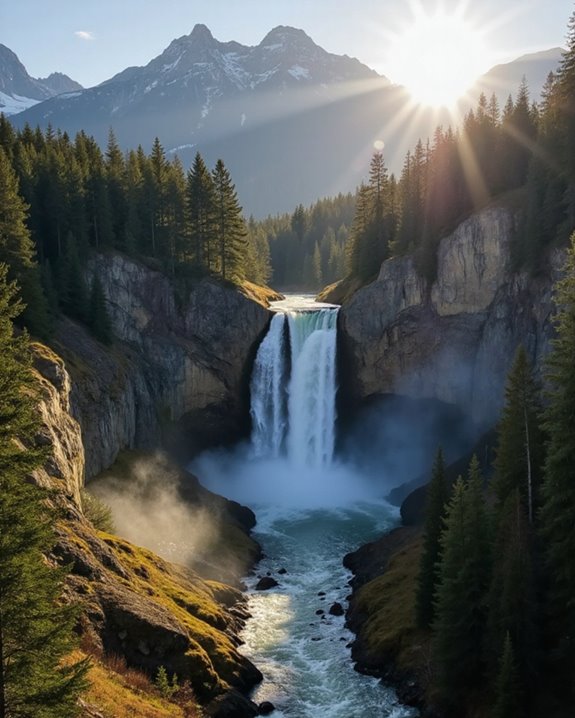
Ever wondered where to point your drone for jaw-dropping aerial photos just outside Seattle’s city limits? The answer is: look for places where history meets nature! Imagine soaring above historic town centers and vibrant cultural landmarks—like the heritage-filled streets of Snoqualmie or old museums tucked away in Issaquah. Capture annual community events or festivals from above; you’ll get a colorful, lively shot every time. For nature lovers, King County’s lush forests, sparkling lakes, and Puget Sound coastlines provide endless inspiration, especially when the seasons change. Those golden autumn leaves or winter’s first snowfall? Perfect for stunning seasonal landscapes! Don’t forget sunrise views from the mountains, or the mysterious look of foggy mornings—your drone might even thank you for the adventure.
Essential Safety Practices for Seattle Drone Pilots
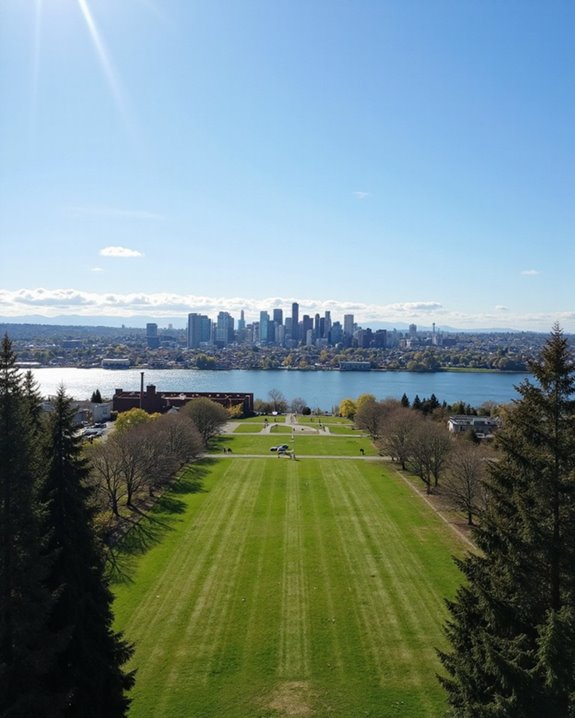
Why risk a crash landing—or a run-in with the law—when a few smart safety moves can keep every Seattle drone flight smooth and fun? Before takeoff, pilots should always complete Weather Checks—Seattle’s famous drizzle isn’t exactly drone-friendly! Don’t forget to register your aircraft with the FAA and finish the TRUST test for recreational flying. Give your drone a careful visual inspection, checking for loose propellers or battery issues, and make sure Remote ID is activated. In flight, keep your drone within sight and steer clear of crowds, vehicles, and restricted areas like the State Capitol Campus. Equipment Maintenance is key: log flights, secure your data, and store drones safely. Stay sharp! Regularly review FAA rules, join workshops, and connect with local pilots.
Resources for Real-Time Airspace and No-Fly Zone Updates

How does a Seattle drone pilot make sure they’re not about to buzz into forbidden territory? Real time Apps are the secret weapon! The FAA’s B4UFLY app delivers up-to-date airspace restrictions, No Fly Alerts, and those pesky TFRs that pop up unexpectedly—no more guesswork. Aloft and Autopilot apps also shine, sending instant No Fly Alerts and integrating FAA data for worry-free launches. If you’re mapping out a route, drone-specific GPS software overlays restricted zones, so you don’t accidentally photobomb the Space Needle! LAANC offers speedy authorization for flights near airports, while the FAADroneZone site is a must for registration and special permissions. Stay in the loop—Seattle’s airspace changes fast, and these tools help pilots fly smart, safe, and legal!
Frequently Asked Questions
Can I Rent or Borrow a Drone Locally in Seattle for Practice Flights?
Rental options for drones in Seattle include local services like ShareGrid, FriendWithA, and Glazer’s Camera, offering in-person borrow locations. Potential renters can choose from various models, verify availability, and arrange short-term practice flights with convenient pickup and return.
Are There Any Drone Flying Meetups or Training Workshops in the Seattle Area?
Seattle’s skyward seekers savor sociable sessions through drone flying meetups and targeted training workshops. Meetup benefits include networking and shared skills, while workshop strategies focus on hands-on learning in photography, mapping, and racing, supporting both novice and experienced pilots.
What Are the Seasonal Weather Challenges for Drone Flying in Seattle?
Seasonal weather challenges for drone flying in Seattle include fluctuating temperatures, frequent rainfall, and unpredictable seasonal winds. Humidity effects can impact drone electronics, while variable daylight and strong winds in autumn and winter further complicate safe flight operations.
How Do I Transport My Drone on Seattle Public Transit or Light Rail?
When considering DroneTransport on Seattle public transit or light rail, individuals should use secure cases, follow TransitRegulations, store batteries safely, and avoid peak hours. Proper documentation, organization, and vigilance help guarantee safe, compliant, and convenient drone transportation.
Are There Repair Shops or Service Centers for Drones in the Seattle Metro Area?
Much like a blacksmith for modern aviators, Seattle’s metro area hosts drone repair shops and authorized service centers, praised for high repair quality and transparent service fees, catering to both recreational pilots and commercial operators seeking expert assistance.

